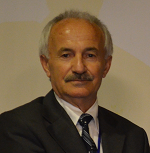
Osman Adiguzel
TurkeyTitle: Nanoscale characterization of phase transformation in shape memory alloys
Abstract:
Shape memory effect is a peculiar property exhibited a series alloy systems in the β-phase fields. Shape memory alloys are sensitive to external condition and temperature, and crystal structure of these alloys change with changing temperature and stressing, by means of structural phase transformation, called martensitic transformations. Shape memory effect is treated thermally by means of thermal induced martensitic transformation, which occurs as martensite variants with lattice twinning in crystallographic or atomic scale, sub-nano scale, in materials on cooling below martensite finish temperature. Twinned martensite structures turn into detwinned martensite structure by means of stress induced martensitic transformation by stressing material in a strain limit in martensitic condition. Shape memory alloys are in the fully martensitic state below martensite finish temperature with fully twinned structure can be easily deformed through variant reorientation/detwinning process. Therefore, martensite is called soft phase and austenite is also called hard phase. Thermal induced martensitic transformation is lattice-distorting phase transformation and occurs as martensite variants with the cooperative movement of atoms by means of shear-like mechanism. Martensitic transformations occur by two or more lattice invariant shears on {110}-type planes of austenite matrix which is basal plane or stacking plane for martensite. In the martensitic transformation, the lattice of high temperature austenite phase has greater crystallographic symmetry than that of the low-temperature product phase. Copper based alloys exhibit this property in metastable β-phase region, which has bcc-based structures at high temperature parent phase field. Lattice invariant shears are not uniform in copper based shape memory alloys, and the ordered parent phase structures martensitically undergo the non-conventional complex layered structures on cooling. The long-period layered structures can be described by different unit cells as 3R, 9R or 18R depending on the stacking sequences on the close-packed planes of the ordered lattice. The close-packed planes, basal planes, exhibit high symmetry and short range order as parent phase. The unit cell and periodicity is completed through 18 layers in direction z, in case of 18R martensite, and unit cells are not periodic in short range in direction z. In the present contribution, x-ray diffraction and transmission electron microscope studies were carried out on two copper based CuZnAl and CuAlMn alloys. These alloy samples have been heat treated for homogenization in the β-phase fields. X-ray diffraction profiles and electron diffraction patterns reveal that both alloys exhibit super lattice reflections inherited from parent phase due to the displacive character of martensitic transformation. X-ray diffractograms taken in a long time interval show that diffraction angles and intensities of diffraction peaks change with the aging time at room temperature. In particular, some of the successive peak pairs providing a special relation between Miller indices come close each other, and this result leads to the rearrangement of atoms in diffusive manner.
Biography:
Dr Adiguzel graduated from Department of Physics, Ankara University, Turkey in 1974 and received PhD- degree from Dicle University, Diyarbakir-Turkey. He has studied at Surrey University, Guildford, UK, as a post doctoral research scientist in 1986-1987, and studied on shape memory alloys. He worked as research assistant, 1975-80, at Dicle University and shifted to Firat University, Elazig, Turkey in 1980. He became professor in 1996, and he has already been working as professor. He published over 60 papers in international and national journals; He joined over 100 conferences and symposia in international and national level as participant, invited speaker or keynote speaker with contributions of oral or poster. He served the program chair or conference chair/co-chair in some of these activities. In particular, he joined in last six years (2014 - 2019) over 60 conferences as Keynote Speaker and Conference Co-Chair organized by different companies. He supervised 5 PhD- theses and 3 M.Sc- theses. Dr. Adiguzel served his directorate of Graduate School of Natural and Applied Sciences, Firat University, in 1999-2004. He received a certificate awarded to him and his experimental group in recognition of significant contribution of 2 patterns to the Powder Diffraction File – Release 2000. The ICDD (International Centre for Diffraction Data) also appreciates cooperation of his group and interest in Powder Diffraction File.
